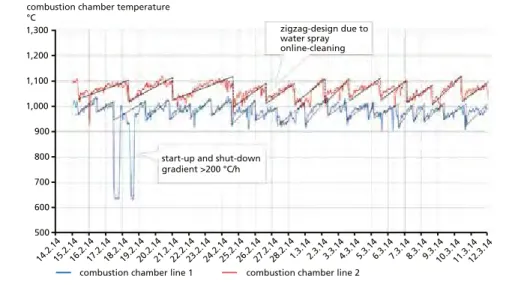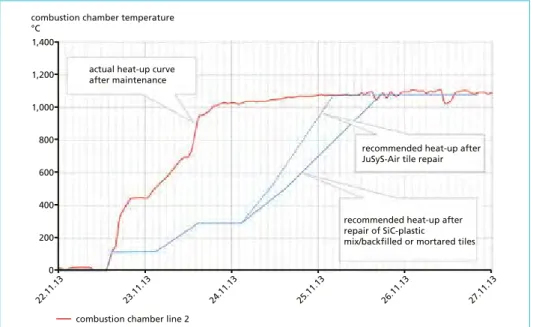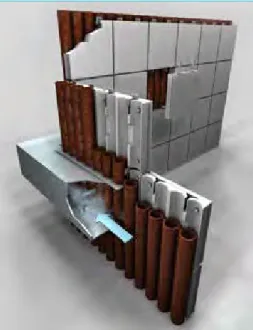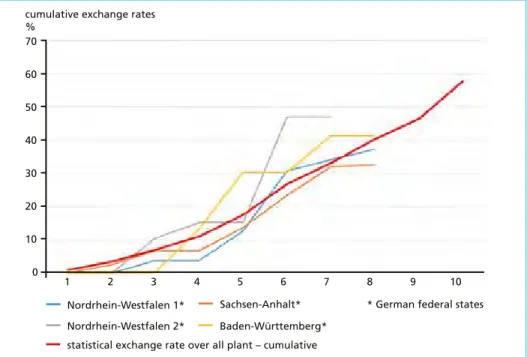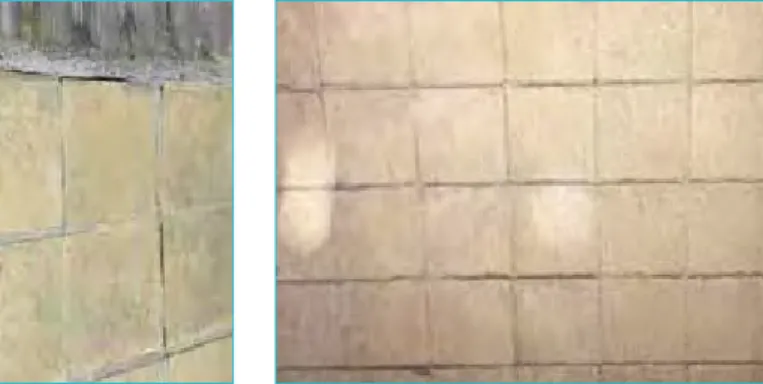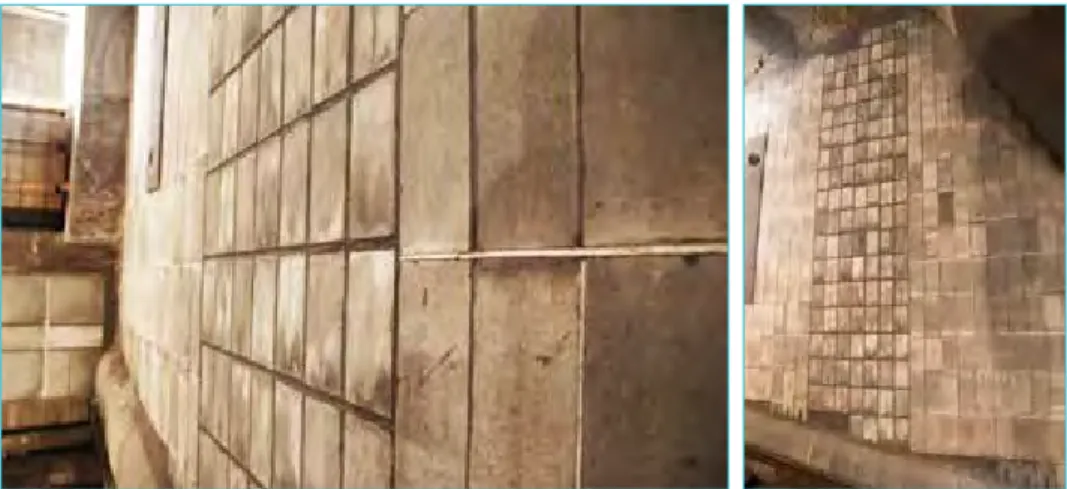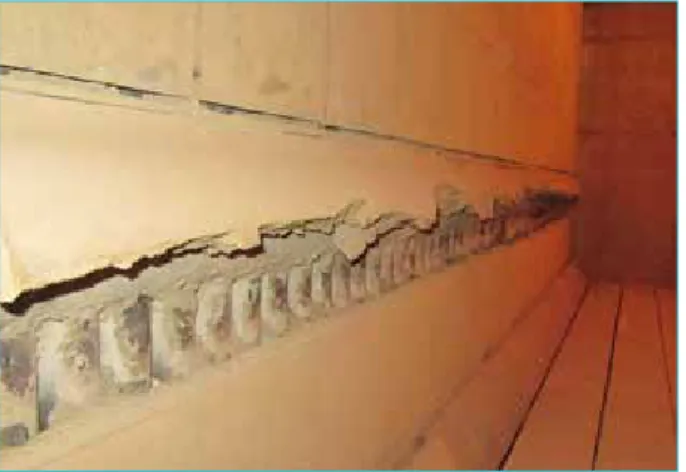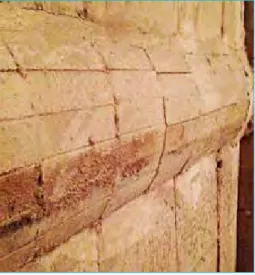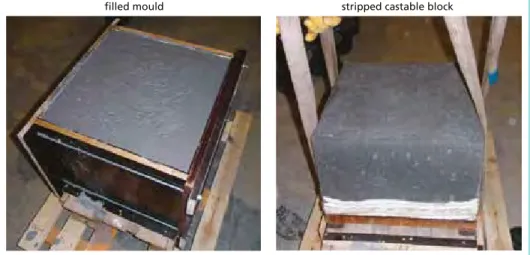Materials and Corrosion
Refractory Engineering for Waste-to-Energy Plants
– Challenges and Solutions of New Constructions and Maintenance –
Markus Horn and Manfred Möller
1. Life cycle management or the art of taking the necessary steps ...502
2. It works also without air ...505
3. Sometimes it is getting hotter ...506
4. The smarter one gives in ...508
5. If you really need it rapid ...511
6. Sometimes you just want to look up ...514
7. Summary ...516
8. References ...516
Increasing demands on availability and longevity of waste incineration plants have brought very good technical solutions to the market in the past, which can be described as ground-breaking from a past perspective.
Where boiler damage and pipe corrosion had to be taken into account, proven and reliable refractory protection systems are existing currently for a long time, especially for protecting the boiler walls.
Normally, the industry could end their work and efforts right now and to be satisfied with what has been achieved. But the market doesn‘t work in such direction. The operators continue to focus on the situation in order to further improvement of their competitiveness and availability.
It has been found, that generally the various systems at the market work are working reasonable up-to very successfully in the view of the overall scale, but further optimi- zations are possible in critical areas and in various details of the system.
Figure 1 is showing the loads on the refractory system which are becoming more and more increasingly critical and must be handled by the refractory suppliers. Much is connected with the increasing expectation of plant availability, others with fluctuating conditions and reactions from the combustion.
Materials and Corrosion
high caloric plastic waste
(RDF)
variation of power density of
the waste influence of combustion control system short an limited
maintance period extension of
maintenance cycle explosion & online
water cleaning huge boiler
dimension
fast start-up
& cool down
high temperature peaks due to DeNOx
refractories
Figure 1:
Load profiles to refractories in the waste incineration
best resistance against thermal
shock erosion resistant
long life time
high chemical resistance
stress relieved insensible against fast start-up
excellent resistance gainst SiC-oxidation high thermal
conductivity high mechanical
strength
refractories
Figure 2:
Requirement profiles for refrac- tory systems
As a result of both load directions, the suppliers are facing a lead to an increased requirement profile for the refractory system and the refractory materials (Figure 2).
Some requirements have already turned out to be essential in the past. The value of the thermal conductivity is already defined by the type of material. The oxidation resistance of the Silicon Carbide material used [7] has also to be proved as a very important quality issue. Irrespective of this, systems are still in demand that can react flexible and robust to the operating conditions of the plants and the modes of operation.
Materials and Corrosion
In reality, another resource turns out to be very critical that can stand against of pos- sible developments:
Communication between operator / engineering company and refractory partner.
economic constraints warranty issue
availability fear of responsibility technical limits
communication
Since all partners have different levels of information and, by their very nature, are pursuing different economic tragets at the same time, there can be stagnations in the development steps and challenges again. Whether in maintenance or in the construction of new plants.
The plant operator may see availability as the highest optimization goal. However, the plant constructor is measured in terms of costs and availability within the warran- ty period of the contract. The refractories partner has in case of a new incinerator first the EPC-partner in front of him and later the plant operator as customer.
Depending on the case, it can lead to completely different results, concepts and lastly to a total different refractory lining.
Figure 3: Conflicts of objectives between the technology partners
Figure 4: Practical refractory load in waste incineration (exemplary)
The refractories partner is not necessarily informed about all processes and operation conditions in the plant or, in some cases, cannot be informed at all (Figure 4). The result of this unknowingness is often a fundamentally very cautious assessment of the performance of its products and designs in order to be on the safe side
500
combustion chamber line 1 combustion chamber line 2 14.2.1415.2.1416.2.1417.2.1
4 18.2.1419.2.1
4 20.2.1
4 21.2.1
4 22.2.1
4 23.2.1
4 24.2.1
4 25.2.1
4 26.2.1
4 27.2.1
4
28.2.141.3.142.3.143.3.144.3.145.3.146.3.147.3.148.3.149.3.1410.3.1 4 11.3.1412.3.14 600
700 800 900 1,000 1,100 1,200 1,300
combustion chamber temperature
°C
zigzag-design due to water spray online-cleaning
start-up and shut-down gradient >200 °C/h
Materials and Corrosion
Figure 5: Load on the refractory system when restarting
For the plant operator, the duration of a recommissioning is of course critical for his direct operating costs and availability, so that he normally tries to optimize these processes as much as possible for himself (Figure 5) in order to improve the availability of the plant.
The refractories partner, on the other hand, sees a large liability risk if damage occurs at the initial start-up or during commissioning of the plant.
The result of these facts is usually a conservative approach of the participants to this topic.
It makes sense here to lead a development in the right direction, an open and very trusting cooperation of all technology partners and persons involved in the projects to optimize the process for higher plant availability.
1. Life cycle management or the art of taking the necessary steps
It is often the case with developments of refractory systems, that a problem during operation of the plant, the assembly or disassembly or the engineering was or is the trigger for new developments. After analysing the problem together with the partners, this results in adapted solutions that can often be tested in the form of test fields and modified systems. The question of liability and risks is usually shared between the operator and the installer. The operator certainly bears the higher risk, but he also has the greater benefit from such a development in the event of success.
In order to resolve the above existing conflict of objectives, it makes sense to create the best possible data base and statistics on all sides for such developments. Because of generally increased personnel fluctuation, both at the customer and at the supplier, such information will become more and more to higher value.
22.11.13 23.11.13 24.11.13 25.11.13 26.11.13 27.11.1
0 3 200 400 600 800 1,000 1,200 1,400
combustion chamber temperature
°C
actual heat-up curve after maintenance
recommended heat-up after JuSyS-Air tile repair
recommended heat-up after repair of SiC-plastic
mix/backfilled or mortared tiles
combustion chamber line 2
Materials and Corrosion
Operators are now increasingly creating their own extensive data base on the durability and availability of refractory systems. Life Cycle Management (LCM) or Wear Data Management (WDM) [10] are important and powerful tools to be used.
Jünger + Gräter began years ago to collect service life data of the ventilated system (Figure 6) to collect and evaluate statistics [12]. This system of rear ventilated tiles has been explained several times [8] and has been in use for a long time [13] with great success [9] in German plants and abroad [1].
Figure 6: Rear ventilated tile system
Even with this product, which is no longer completely new today, initial concerns had to be dispelled, e.g. by model calculations [3, 11].
In addition, the very open, good and trustful cooperation with the operators led this system becoming the most inves- tigated refractory tile system in Germany.
Studies and durability considerations have been carried out in various publications on various plants [4, 6, 8].
The system has proven its reliability in modern waste incineration plants for more than 18 years.
In total 118 lines are now operating with the ventilated system. The total protected area is above 25,000 m².
1 2 3 4 5
year of operation6 7 8 9 10 relative exchange rate
per year
%
cumulated exchange rate per year
%
0 2 4 6 8 10 12
0 10 20 30 40 50 60
exchange rate over all boilers – cumulative exchange rate over all boilers – per year
Figure 7:
Service life statistics as a measure of reliability
Materials and Corrosion
After 2012, the service life data were re-evaluated in 2016, and it came to no surprise that the trend was similar and only slightly improved. In 2012, the 50 % cumulative exchange rate was reached after approximately 8.5 years. In the renewed survey only one year later, means after approximately 9.5 years. This is reasonable, because the wear rate of the large-scale plants erected from 2009 until 2011, e.g. in London and Paris, perform extremely well and thus have a positive impact on the overall statistics.
In the more current survey (2016) 80 plants with 21,000 m³ were included. However, an attempt was also be made to determine individual annual performance of each plant. With this survey the analysis method reaches its limits for an annual analysis.
Means an individual annual forecast of refractory wear of an individual plant is not possible (Figure 8).
Table 1: Service life statistics as a measure of reliability – Data of Figure 7
year of operation 1 2 3 4 5 6 7 8 9 10
no. of boilers 80 70 65 63 55 35 30 21 12 6 exchange rate
over all boilers – per year % 1 2 4 4 7 9 6 7 6 11 exchange rate
over all boilers – cumulative % 1 4 7 11 18 27 33 40 47 58
The statement, which cannot be convey from Figure 8, looks more logic in the accu- mulated analysis. The same four plants, which are not predictable on an annual basis, provide a fairly uniform picture on an accumulative basis (Figure 9). The values usually spread relatively close to the mean value of the exchange rate of all systems.
Figure 8: Statistical spread of the annual exchange rate
1 2 3 4 5 6 7 8
0 5 10 15 20
exchange of tiles per boiler maintenance
%
25 30 35
Sachsen-Anhalt*
Baden-Württemberg*
Nordrhein-Westfalen 1*
Nordrhein-Westfalen 2*
* German federal states
Materials and Corrosion
2. It works also without air
In the past, the ventilated system JuSyS Air has proven to be very reliable and robust in a wide variety of countries, incinerators and areas. Due to its thermal properties, compared to tile systems that are directly connected to the boiler walls without an air gap, it can only be used to a limited extent in the thermal highly stressed areas of the boiler due to the reduced heat transfer character of JuSyS Air overall system.
From this fact two new fundamentally different strategies were born:
On the one hand, the system can also be installed in thermal highly stressed areas in order to achieve only limited durability combined the well-known good corrosion protection under the presumption of a higher burn-off rate of the Silicon Carbide ma- terial at the surface of the tiles. This approach is justified by the advantage of the very short dismantling and reassembly times of JuSyS Air without any great sandblast or clean of the surfaces. In practice, it was sometimes the case that even the existing tile anchor could be used for a second application. Eliminating the risk of boiler damage from demolition hammers is also an advantage compared to other systems.
Secondly, a hybrid was created between the ventilated system and the back-filled JuSyS SL (StressLess) system. Although the costs of this new system are somewhat higher due to the greater wall thickness of the plates, the higher robustness of the tile design easily justifies this additional use in various systems. The following advantages compared to other tile systems can be summarized as follows:
Figure 9: Statistical spread of cumulated exchange rates
1 2 3 4 5 6 7 8 9 10
0 10 20 30 40 70
cumulative exchange rates
%
50 60
statistical exchange rate over all plant – cumulative Sachsen-Anhalt*
Baden-Württemberg*
Nordrhein-Westfalen 1*
Nordrhein-Westfalen 2*
* German federal states
Materials and Corrosion
The advantages are:
• for increasing the thermal conductivity in case of high burn-off risk of the tile surface (auxiliary burner area, secondary air zone, lower combustion chamber, grate zone),
• solid tile with higher wear allowance,
• only one uniform tile shape for the entire boiler (storage),
• very stable system at high mechanical and thermal load due to the tile thickness respectively geometry,
• successful use as a special solution over ten years.
Figure 10: JuSyS Air BF (Back Filled) JuSyS Air BF (Back Filled)
Externally, the tiles of the new system cannot be visual separated from the standard ventilated tile walls. The adaptation is very simple and flexible in thermally high loaded boiler areas. The need for ventilation air in these areas is not applicable. If rear ventila- tion is already planned during the engineering phase of a new plant, the boiler can be adapted significantly better to changing waste compositions or other process-related changes over his full service life. This is particularly interesting for countries that do not have many years of experience in waste management and therefore not experience of waste composition or the caloric value level over the year. Therefore it is possible to design the system as a backfilled version in the early stage of the plant as initial lining design, if it is suitable for low caloric waste. Should the proportion of high-caloric plastic waste increase over the years and the economic development of the country, it is possible to switch the system to rear ventilation without great modification effort. For developing countries in particular, this variant offers enormous flexibility in the design of the plant with the possibility of adaptation in the life cycle of the plant.
3. Sometimes it is getting hotter
In addition to the ventilated tiles, thousands of square meters of glued or mortared standard tiles are also used. Although the tiles are not as robust as the significantly heavier, durable and therefore more expensive ventilated tiles, they have a significant higher heat transfer and thus better energy efficiency.
Materials and Corrosion
The standard system has been used for decades in many plants with great success.
However, with extremely high local energy densities, caloric values and temperature differences, it has been detected as disadvantage that the relative small and tight expansion-mortar joints between the individual tiles do not compensate the thermal and long-term irreversible expansion of the SiC-tiles in perfect manner.
Due to the very good experiences with the dovetail joint of the ventilated system, a synergy between the two known and proven systems was chosen as solution for such extreme conditions.
The advantages are:
• Extremely high thermal conductivity e.g. standard system,
• System is able to slide partially independent of the boiler – similar to the ventilated system,
• Circumferential expansion joint to compensate for high temperatures and due to this higher oxidation rates of the SiC,
• closed expansion joints – therefore low corrosion potential,
• Easy replacement – similar to the standard system,
• Smaller almost square tiles – therefore a higher flexibility against bending stress.
Figure 11: JuSyS XC in reference situation with the standard system
A new tile system was designed (Figure 12), which has an individual, circumferential expansion joint with Z off-set at each joint and at each tile anchor to prevent direct gas penetration.
The 90 % SiC plastic mix in the dovetail joint covers the expansion fiber paper in the horizontal and vertical joints. The anchor parts are also provided with their own expansion insert to prevent bending stress in front of the tile and to allow a certain degree of flexibility between the tile system and the boiler.
Materials and Corrosion
4. The smarter one gives in
In fact – as already mentioned – many new developments result from problems in existing plants. In the waste incinerator plant RRRL in London Riverside, a horizontal collector has been engineering from the engineering company in the middle of the intermediate wall to stiffen the 12 meter-wide boiler wall.
Since there were three large lines, each with 580 m² of ventilated tiles, the refractory lining was not made with a monolithic solution, as is often in such cases. It was realised with a special shaped nitride bonded SiC-tile, following perfect the geometry of the collector.
Unfortunately, considerable stresses or displacements must have occurred in the area of the collector due to too high heat-up gradients, which ends-up in the defect of the special shaped tiles at the collector.
In straight wall section of the tile-system this higher stress gradients are normally not a problem for JuSyS Air. Tor years it has been tolerated such conditions without any problems due to the high compressive strength of the SiC material in combina- tion with the solid tile structure. Unfortunately, in case of the horizontal collector, it has not worked in the same manner. Here the compressive stress leaves the vertical direction of the boiler wall and creates a resulting tensile stress in the rounding of the shaped brick in the direction of the combustion chamber. However, tensile stresses are much worse to bear than compressive stresses for all ceramic materials. Therefore, the special shaped tile at the collector failed completely within a relatively short period of operation (Figure 13).
Figure 12:
Design details
Materials and Corrosion Figure 13:
Problematic horizontal collector at the level of 12 meter After identification and understanding of the defect mechanism a solution had to be designed that could permanently withstand the current loads and could be integrated into the existing tile system. Furthermore the new design has to ensure an adequate and sufficient air supply to the boiler wall above the collector.
The developed solution included a completely new concept (Figure 14, Figure 15) of collector lining. Firstly, to separate the load-carry function and the refractoriness in two different system components and secondly to compensate the occurring compression stress in a displacement resp. twisting with small ceramic elements.
The temperatures near the boiler wall are in such a temperature level, that a high-tem- perature resistant stainless steel can withstand this conditions without being damaged.
Due to this the load-carry function is taken over by the special metal construction, which is ventilated with sealing air at all sides and therefore also protected against corrosive flue gas. The metal retaining construction is finally holding the many small ceramic bars, which protects and seal the total system. Under compression and stress the metal construction can compensate this pressure by being deformed. The ceramic bars will move and open-up smaller joints at the hot face without losing their tightness or protective function.
Figure 14: JuSyS Flex, the concept
Materials and Corrosion
Due to the very good experience with the new concept, the application area was extended to all horizontal collectors in the three boilers. Furthermore we en- hanced the JuSyS Flex System for other stress reliefed areas e.g. in corners, bends and transitions between lining zones of different systems (Figure 16, Figure 17).
Another new aspect is the use in particu- larly large boilers in flat wall areas. JuSyS Flex can act here as a refractory expansion joint to reduce significantly stresses due to the possible expansion absorption.
The concept is patent pending and disc- losed [2].
Figure 15: In operation since 2014 mainte- nance-free
Figure 16: Solving strain-stressed situations
Figure 17:
Transition between tile systems The system naturally makes a higher benefit due to the possibility of absorbing stresses and strains in order to facilitate faster start-up and shut-down processes.
Materials and Corrosion
5. If you really need it rapid
The already described expectation of the plant operators to reduce the duration of commissioning and recommissioning leads to further developments in the field of refractory technology.
The period of the first dry-out of a waste incineration is not necessarily significant for the operating costs of the total service life, but it is also of considerable value. However, the costs for start-up after a maintenance service exceed this value many times, because it significantly reduces the availability of the plant and every day of non-operation costs a lot of money.
Therefore, innovative refractory technology is required, in particular to develop so- lutions for rapid heat-up without making major compromises in the quality of the installed products (Figure 2).
However, the higher costs for more expensive raw materials, components and binders are not in proportion to the saved costs for fuel and downtime.
Therefore the topics dry-out and heating up must be considered fundamentally different.
Dry-out of a refractory castable is correlated with the water present in the castable and with the vaporised water. Heating up is only correlating with the temperature increase and the expansion differences of the refractory systems and the boiler construction in the individual zones of the plant.
At higher temperatures, steam can generates considerable high vapour pressures that slightly can exceed the green strength of the castable or refractory mortar. In this case, cracks, layers or joints would generated (Figure 23), or this pressure can lead to an explosive destruction of the refractory (Figure 21).
filled mould stripped castable block
Figure 18: Preparation of a sample for the trial series
The target must be the developing of refractory binding systems, which need extremely less water for application, alternative to be water-free or release the water in an early stage at a sufficiently high speed via the surface of the lining without any cracks or damage.
Materials and Corrosion
Both characteristics were combined and realized with the new JuFast concretes.
After the laboratory tests, samples were produced in a dimension and thickness close to industrial conditions (Figure 18) and subjected to more severe test conditions (Figure 22).
temperature display for burner control
peep hole gas burner
Figure 19: Trial set-up / front end
Thermocouple
(1 cm ahead of test sample)
Figure 20: Trial set-up / rear end
Materials and Corrosion brick cutting saw
unacceptable crack formation
cutted trial block
Figure 23: Unacceptable cracking of a conventional castable
Figure 22:
Heat-up tests with 200 K/h temperature heat-up
temperature
°C
0 19 November
9:00 19 November
15:00 19 November
21:00 20 November
3:00 20 November 9:00 150
300 450 600 750 900 1,050
Figure 21:
Trial series with standard low cement castabl
Materials and Corrosion
Figure 24: No cracking with High Performance Concrete HP100Q
In summary, it was determined that JuFast concretes allow an initial start-up or drying out of 100 K/h without any holding times or slow-down of the heat-up gradient. They are available as cast and gunning and do not require any special personal protective equipment, as is otherwise necessary other rapid heat-up castables with acid binders in the market.
6. Sometimes you just want to look up
A further innovation should be seen in connection with shortening inspection times and costs. The inspection of boiler via an externally video-monitored and controlled inspection drone.
Drones are probably known today as toys or hobby equipment.
In recent years, however, drones have also become established as an inexpensive tool in the field of ground monitoring, inspection of high-voltage lines, chimneys, wind power plants and buildings.
Consequently, it was only a matter of time before maintenance engineers tried to fly in their boilers to create photos and videos without having to erect an expensive and time-consuming scaffolding.
However, it has now been shown that commercially available drones, which are made for outdoor and hobby use in boilers, although inexpensive, are only in principle suitable.
The disadvantages result from the confined space, the visual and thermal conditions in the boiler. To eliminate these well-known weaknesses, a special type of interior drone was developed, which is distinguished by various special features:
cutted castable block without cracks
Materials and Corrosion Figure 25: Boiler inspection with a JuSpect drone
The advantages are:
• Entire drone is integrated in a double gimballed spherical cage and protects the rotors,
• which maintains the flight characteristics when the drone comes into contact with the wall,
• Wall access possible at a defined distance (unrolling),
• Very powerful headlights,
• Powerful push propellers that suck in dusty air from above,
• Camera position above the propellers, tilts upwards and remotely controlled,
• FPV (First Person View, camera view as if sitting in the cockpit of a flying object) in VR-Glasses (virtual reality),
• Good accessibility even to small openings and very narrow spaces,
• Relay antennas can transmit control and video signals into the boiler,
• Integrated infrared (IR) camera.
The disadvantages are:
• Extremely high investment costs,
• Experience as inspection pilot necessary – thermic and orientation in complex plant sections,
• Experience with the evaluation of FPV videos is necessary, in order to recognize directly on site lacking information,
• Quite short uninterrupted flight and inspection time of maximum 20 minutes (in- cluding the return journey),
• Partial linkage of the protective cage visible (but no functional limitation).
Materials and Corrosion
Figure 26: JuSpect in a confined space and in IR mode
7. Summary
In conclusion, it can be said that technical development and refractory engineering are strongly dependent on the problems and further developments in process engineering, but also on the mode of operation and the composition of the waste. The company is constantly confronted with new challenges and problems that cannot be planned or predicted. However, it is the driving force for innovation and further development of the systems, special and individually tailored to customer needs. Particularly in the in- ternational environment, there are opportunities for further innovation of the products and service, since these markets should benefit from the experience and knowledge of established and competent companies in the market of incineration and not make the same mistakes or reinvent the wheel.
List of abbreviations RSW right side tile LSW left side tile
RW rear wall / partition wall for 2nd train VW front wall
8. References
[1] Born, M.; Beckmann, M.: Korrosionsschutzmaßnahmen in Abfallverbrennungsanlagen und Ersatzbrennstoff-Kraftwerken – Auswertung einer Betreiberbefragung. In: Thomé-Kozmiensky, K. J.; Beckmann, M. (Eds.): Energie aus Abfall, Band 9. Neuruppin: TK Verlag Karl Thomé- Kozmiensky, 2012, pp. 393-410
[2] Herz, V.; Horn, M.; Möller, M. D.: Feuerfestsegment. D Patent DE102016114177A1, 01 08 2016 [3] Horn, M.; Aleßio, H.-P.; Bratzdrum, C.; Brell, J.; Molitor, D.: Wärmeübertragungsverhalten von
hinterlüfteten Platten am praktischen Beispiel einer Abfallverbrennungsanlage. In: Thomé- Kozmiensky, K. J.; Beckmann, M. (Eds.): Energie aus Abfall, Band 8. Neuruppin: TK Verlag Karl Thomé-Kozmiensky, 2011, pp. 325-344
Materials and Corrosion [4] Horn, M.: JuSyS Tube Wall Protection -Technology, Experience and Commercial Aspects -. In
PREWIN, Mannheim, 2011
[5] Horn, M.; Kolbitsch, P.; Madl, F.: Keramische Rohrwandplattensysteme in Wirbelschichtfeue- rungsanlagen – Alternativkonzeption zur konventionellen Auskleidung mit Feuerfestbeton am Beispiel des EBS-Kraftwerks der Linz AG. In: Thomé-Kozmiensky, K. J.; Beckmann, M. (Eds.):
Energie aus Abfall, Band 9. Neuruppin: TK Verlag Karl Thomé-Kozmiensky, 2012, pp. 491-519 [6] Horn, M.; Schuierer, F.; Drexler, J.; Beul, H.-G.: Acht Jahre hinterlüftetes Plattensystem – JuSys
Air. In: Thomé-Kozmiensky, K. J.; Beckmann, M. (Eds.): Energie aus Abfall, Band 6. Neuruppin:
TK Verlag Karl Thomé-Kozmiensky, 2009, pp. 519-544
[7] Imle, J.: Feuerfeste Werkstoffe für Abfallverbrennungsanlagen – Eigenschaften und Anforde- rungsprofil. In: Tagungsband Dampferzeugerkorrosion; SAXONIA , Freiberg, 2007
[8] Imle, J.: Hinterlüftetes keramisches Rohrwandschutzsystem – Problemlöser für kritische Be- reiche von Abfallverbrennungsanlagen. In: Thomé-Kozmiensky, K. J.; Beckmann, M. (Eds.):
Optimierung der Abfallverbrennung 3. Neuruppin: TK Verlag Karl Thomé-Kozmiensky, 2006, pp. 681-697
[9] Kaiser, M.: Untersuchung hinterlüfteter und geklebter Plattem J+G System ca. 80.000 Bh. Che- min, Augsburg, 2011
[10] Kiehne & Partner GmbH: WDM, 2016
[11] Magel, G.; Molitor, D.; Bratzdrum, C.; Koch, M.; Aleßio, H.-P.: Wie kommt die Wärme ins Rohr? – Korrosion ist oftmals ein Symptom hoher Wärmestromdichte. In: Thomé-Kozmiensky, K. J.; Beckmann, M. (Eds.): Energie aus Abfall, Band 9. Neuruppin: TK Verlag Karl Thomé- Kozmiensky, 2012, pp. 373-390
[12] Möller, M.; Horn, M.: Langfristerfahrung mit hinterlüfteten Platten über mehr als zehn Jahre–
Ein Überblick. In: Thomé-Kozmiensky, K. J.; Beckmann, M. (Eds.): Energie aus Abfall, Band 10.
Neuruppin: TK Verlag Karl Thomé-Kozmiensky, 2013, pp. 503-523
[13] Schumacher: Deutsches Patentamt; Offenlegungsschrift DE19816059 A1. 1999. Deutschland Patent Offenlegungsschrift DE19816059 A1. 1999, 1999
[14] Zickert, U.: Improvement of the availability of MVV’s WtE plants. In: PREWIN General Assem- bly, Mannheim, 2011
Contact Person
Dipl.-Ing. Markus Horn Jünger+Gräter GmbH Managing director Robert-Bosch-Straße 1 68723 Schwetzingen GERMANY
Phone: 0049 - 62 02 - 9 44 - 1 44 Email: m.horn@jg-refractories.com
Download Free Articles
on www.vivis.de
waste incineration
photovoltaic
flue gas treatment
balancing and evaluation
bio waste
biogas
biomass
soil steam generator
dismantling
waste incineration
dismantlingwaste incineration
landfill
emission trading
pyrolysis
solid recovered fuels
logistics
district heating, district cooling, process steam
odour
sewage sludge
corrosion and materials
mechanical-biological treatment
mechanical treatment
mineral by-products and wastes
co-incineration
electricity grids
physical- chemical treatment
planning
legislation
recycling
electricity grids
recycling
electricity grids residues
solar thermal energy
recycling
solar thermal energy
recycling energy storage
photovoltaic
energy storage
photovoltaic
drying
turbine and generator underground storage and backfilling of mines
waste generation
fan and stack
gasification
wind power
profitability
HOW DO I FIND RELEVANT ARTICLES?
Alternative 1: Search by topic
If you are looking for articles regarding a specific topic, please go to Fachbeiträge (i.e. free articles, in the top right corner of our homepage). If you select the subcategorie Beiträge you will get complete list of the topics in alphabetical order. Most of them are further divided into sub-themes. Just click on your topic of interest, and you will find the available relevant articles with their bibliographical data. In order to open and download the article, click on the articles title.
Alternative 2: Search by conference
If you are looking for articles regarding a specific conference/congress or book, please go to Fachbücher (i.e. reference books, in the top right corner of our homepage). Here you find a list of the themes, which are covered by our publications.
Choose your field of interest. You will then see all relevant books listed in the order of their release date, starting with the latest publication. The latest publications are recapped under the categorie Neuerscheinungen (i.e. new releases). Once you find the right book, follow the link Inhaltsverzeichnis (i.e. table of content). In order to open and download an article published in the book, click on the articles title.
If you are interested in another article of the same book, you should consider buying one directly on our website. Available books you can order at Fachbücher .
Dorfstraße 51
TK Verlag GmbH
Bibliografische Information der Deutschen Nationalbibliothek Die Deutsche Nationalbibliothek verzeichnet diese Publikation in der Deutschen Nationalbibliografie; detaillierte bibliografische Daten sind im Internet über http://dnb.dnb.de abrufbar
Thiel, S.; Thomé-Kozmiensky, E.; Winter, F.; Juchelková, D. (Eds.):
Waste Management, Volume 8 – Waste-to-Energy –
ISBN 978-3-944310-42-8 Thomé-Kozmiensky Verlag GmbH
Copyright: Elisabeth Thomé-Kozmiensky, M.Sc., Dr.-Ing. Stephanie Thiel All rights reserved
Publisher: Thomé-Kozmiensky Verlag GmbH • Neuruppin 2018 Editorial office: Dr.-Ing. Stephanie Thiel, Dr.-Ing. Olaf Holm,
Elisabeth Thomé-Kozmiensky, M.Sc.
Layout: Janin Burbott-Seidel, Ginette Teske, Roland Richter, Cordula Müller, Sarah Pietsch, Gabi Spiegel, Lena Bischkopf
Printing: Universal Medien GmbH, Munich
This work is protected by copyright. The rights founded by this, particularly those of translation, reprinting, lecturing, extraction of illustrations and tables, broadcasting, micro- filming or reproduction by other means and storing in a retrieval system, remain reserved, even for exploitation only of excerpts. Reproduction of this work or of part of this work, also in individual cases, is only permissible within the limits of the legal provisions of the copyright law of the Federal Republic of Germany from 9 September 1965 in the currently valid revision. There is a fundamental duty to pay for this. Infringements are subject to the penal provisions of the copyright law.
The repeating of commonly used names, trade names, goods descriptions etc. in this work does not permit, even without specific mention, the assumption that such names are to be considered free under the terms of the law concerning goods descriptions and trade mark protection and can thus be used by anyone.
Should reference be made in this work, directly or indirectly, to laws, regulations or guide- lines, e.g. DIN, VDI, VDE, VGB, or these are quoted from, then the publisher cannot ac- cept any guarantee for correctness, completeness or currency. It is recommended to refer to the complete regulations or guidelines in their currently valid versions if required for ones own work.
